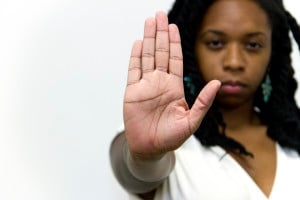
A young person wearing a denim jacket stands with their hand on their hip. In the background, a clothing drive is happening with piles of clothes on tables and hanging from racks, with people gathered around.
People think it’s easy to spot the homeless in our communities because many of us hold onto harmful stigmas. I have worked in Homeless Services for four years and have seen it all.
As someone who deals with both the general public through standup comedy and the homeless through my job, here are a few things you’re probably getting wrong about homelessness.
1. “If Homeless People Would Just ‘Get a Job,’ It Would Fix All of Their Problems”
Homelessness, much like other social problems, can’t be solved with a blasé attitude.
Having a source of income, while important, doesn’t automatically fix homelessness.
Rents are skyrocketing and the cost of living goes up frequently without adequate adjustments in working wages. A person can be homeless and work two or even three jobs.
If a person is temping through an agency, they are often seen as expendable labor, but because they’re dependent upon the little income they receive, they put up with abuses and low wages. Also, having a job doesn’t mean very much if you can’t afford to live.
Affordable housing and rent-controlled apartments, or even subsidized housing through section 8 is very limited. Over 13% of the nation’s supply of low income housing has been permanently lost since 2001 and families with low incomes are left to figure things out for themselves.
“What about the homeless people who don’t work?”
Have you thought about how homelessness might make looking for a job that much harder?
A laptop is useful but not if you can’t keep it safe from theft or don’t have access to Wi-Fi. When you have no address, how do you fill out a job application? Or how do you get your mail delivered?
There are plenty of everyday things we take for granted that homeless people don’t have access to like showers, bathrooms, laundry, and kitchens.
Literally every single part of your life changes when you don’t have a secure place to live.
2. “If I Give Homeless People Money, They’ll Just Buy Drugs or Alcohol”
An individual may buy drugs or alcohol, but when you give someone money, they spend it on necessary expenses, and as it turns out, being homeless is expensive.
A homeless person on GR (General Relief) receives about $221 a month in emergency benefits, but they can only receive GR for nine months if they’re eligible for work. And if they happen to become employed, they’ll have to pay back the full amount. An individual can also apply for food stamps, and that comes out to about $143 monthly.
Imagine having to meet your needs on roughly $360 a month. And I don’t just mean food, but other expenses as well: tents, nights in a hotel, blankets, clothes, food, gas, bus passes, soaps, shampoos, personal hygiene, and so on.
Drug problems make up a very small percentage of why people become homelessness. Drug and alcohol abuse has been perpetuated through media, and it has a real impact on the opinions and biases held against homeless people.
Dealing with the day-to-day of living homeless creates a high degree of stress, so drugs or alcohol is how some people cope or self-medicate. How many of the people in your life use marijuana, alcohol, tobacco or caffeine to manage their stress after a long day at work?
How much more stressful do you think homelessness is than a day at your job?
3. “If a Person Becomes Homeless, They Probably Did Something to Deserve Their Situation”
I’ve seen adults and families with chronic health conditions prevent them from working high-paying jobs or receiving adequate disability benefits and that leads them into homelessness.
Debt has also been another undermentioned factor. And since the Great Recession in 2008, thousands of people were let go from their jobs without leads or severance pay to keep them and their families afloat.
Some people are escaping relationships with abusive partners. Some don’t have the support from family or friends, and most fear that their abusive partner will find them if they turn to people they know for help. Domestic violence isn’t talked about nearly enough as a reason people become homeless.
Yes, mental health can and sometimes does play a factor, but it also often ties into an individual’s support system. People with mental health challenges are at risk for abuse behind elder adults and adults that are disabled.
Lastly, most of the people I work with are homeless simply because they’ve lost their source of income. A large portion of American workers could not last three months without burning through their savings.
On average, it takes people 3-6 months to find a new job after losing one – and in that short period of time, it’s very easy to become homeless.
4. “Homeless People Shouldn’t Have Luxury Items, Like Cellphones or Computers”
It’s very easy to think in terms of what people “deserve” to have, especially when they are poor or homeless.
Society wants the poor to be really poor and the homeless to be joyless, so when homeless people have small things like cellphones or laptops, some people actually get angry.
However, the people who get angry fail to realize there are several government programs, like Lifeline or The Universal Service Fund, more commonly called “The Obama Phone Program” that help homeless people and people with very low incomes get subsidized cell phones.
Cell phones are a necessary part of staying in touch with family, social services workers, and are essential tools in looking for employment.
5. “Homeless People Shouldn’t Have Pets”
Pets are wonderful companions and can offer affection and protection.
Physical and sexual violence are very real threats to homeless people. According to the NSHAPC, The National Survey of Homeless Assistance Providers and Clients, over 40% of homeless people experience theft, robbery, or assault – and only 26% of homeless people in another survey said they knew of a safe place to sleep at night. So having a pet that can alert you or help keep you safe is lifesaving.
Companionship is also very important. People escaping violence or those who don’t have a safety net of friends and families rely on their pets for comfort and solace. Pets also help with depression and loneliness and can give people a sense of purpose.
6. “It’s Easy to Know Who Is Homeless”
When we talk about homelessness, there are really two types of homelessness: seen and unseen.
Seen homelessness is what people who have generally never been homeless think of. They think of stereotypes of what homelessness is. They think of someone with poor hygiene who may have some mental health issues, asking for spare change.
Unseen homelessness is the thousands of people who may be employed, well groomed, and not suffering from mental health challenges, who live in their cars or stay temporarily with friends on their couches.
They’re the ones who often get told “you don’t look homeless,” which is an insulting thing to say because it’s a qualifier. It’s the same as saying “pretty for a fat woman, or saying that a person of color is well spoken.”
The safety nets that are supposed to keep people out of the cycle of poverty aren’t very effective because they’re underfunded or come with very rigid requirements. For example, most homeless shelters are on a ninety day cycle, meaning a person has ninety days from the day they’re accepted into a shelter to figure out their next step before being forced to leave that shelter.
Unfortunately, a lot of shelters are run through religious institutions, so they may carry harmful attitudes and practices. Some have excluded trans men from the men’s dorm or trans women from the women’s dorm because they don’t recognize their gender identities.
Some shelters force prayer multiple times a day or partaking in mandatory bible studies as part of their stay, and it is most often Christian, so other faiths or non-faiths are put in the uncomfortable position of following a religion that isn’t theirs in exchange for safety.
Also, some cities have criminalized homelessness by issuing citations, allowing police to physically and verbally harass homeless people. These citations can be hundreds of dollars, and without an income, the fines often double within ninety days, and then turn into warrants. A person can easily end up with a misdemeanor on their record simply for being homeless and without an income.
Cities have passed laws that outlaw like sleeping in cars, pan handling, or loitering in public places. These laws specifically target the homeless and punish them for trying to survive. Other measures – such as spikes under bridges and destroying homeless encampments with bulldozers or razors – send powerful messages to people looking for safety and security: You will not find it here, move on.
There’s been a push by advocates and homeless groups to pass a “Homeless Bill of Rights” and add it to the state constitutions. So far, only a few of them have been successful in passing it: Rhode Island, Connecticut, and Illinois.
The main goal of the Homeless Bill of Rights is to ensure that homeless individuals are protected against segregation, laws targeting homeless people for their lack of housing and not their behavior, and restrictions on the use of public space.
The bill also grants reasonable privacy and property protections. It calls to allow homeless people the opportunity to vote and feel safe in their community without fear or harassment. Also, it provides broad access to shelter, social services, legal counsel, and quality education for the children of homeless families.
As of 2016, there are only a handful of states that are even considering such legislation: California, Delaware, Maryland, Minnesota, Missouri, Oregon, Puerto Rico, Tennessee, Vermont, and Wisconsin.
***
Nobody likes homelessness, but there are real, tangible solutions. The answer sounds simplistic, and it really is. It’s the most cost effective, and the most successful in solving chronic homelessness: Just give people a place to live.
No strings attached. That’s it. Give people places to live.
That statement sends waves of reactionary anger through some people. “You’re going to give people places to live?” Yes, because it saves 3-4 times the amount of money settling a family or individual into a unit than it does to allow them to bounce around searching for safety and security.
Once an individual or family is secure, their other needs can be easily met because they’re in a fixed location. Employment, drug treatment, medical treatment, child care, mental health services, all become much more manageable when people have some peace of mind and aren’t left outside.
If you don’t like homeless, be part of the solution to fixing it. Nobody deserves the challenges that are associated with homelessness, especially when we have the resources to fix it.
[do_widget id=’text-101′]
Derrick Lemos is a Los Angeles based comedian, writer, and film maker. He believes that emphasizing historical and cultural context is a key component to understanding modern intersectional issues. He also loves professional wrestling. Follow him on Twitter @DerrickLemos.
Search our 3000+ articles!
Read our articles about:
Our online racial justice training
Used by hundreds of universities, non-profits, and businesses.
Click to learn more




















